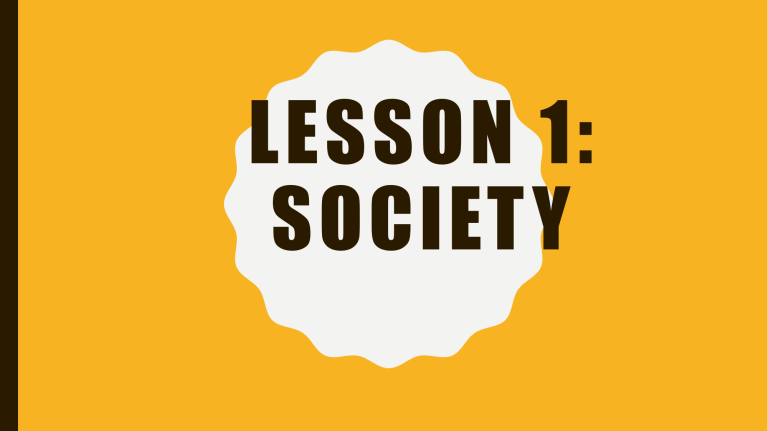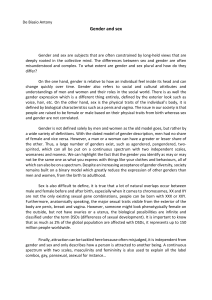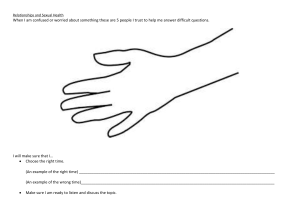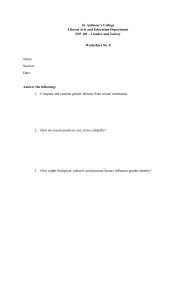
LESSON 1: SOCIET Y WHAT IS SOCIETY • Refers not to a group of people but to the complex pattern of norms of interaction that arise among them. • Society is process rather than a thing, motion rather than structure. • Macionis (2017) defined society as people who interact in a defined territory and share a culture NATURE OF SOCIETY • Society is universal among humans and it has performed primary adaptive functions that have increased the chances of human survival. • It is considered as the counterpart of the adaptive biological mechanisms that cause one species to survive and another to become instinct. CHARACTERISTICS OF HUMAN SOCIETY 1. it is a social system 2. it is relatively large 3. it recruits most of its members from within 4. it sustains itself across generations 5. it shares a culture 6. it occupies a territory TYPES OF SOCIETIES 1. hunting and food gathering 2. horticultural 3. pastoral 4. agricultural 5. industrial 6. post industrial FOUR CONDITIONS TO THE DISSOLUTION OF SOCIETY 1. if members are killed off 2. if members become apathetic 3. if society falls into a state of chaos from which it cannot free itself 4. if society is absorbed into another society Now Showing These are videos presenting different views in understanding the origin and types of society. • I am encouraging everyone to watch the listed video links. 1. Human Society Classifications, Classified by different social scientists. Uploaded by Social Sciences (2016) • https://www.youtube.com/watch?v=XGcmTs7nj44 2. Sociology Lesson 10 – Types of Societies. Uploaded by Scott Muller (2014) https://www.youtube.com/watch?v=GEzwJLbJF-M 3. Types of Societies in Sociology Video & Lesson Transcript. Uploaded by shadow1212u (2016) • https://www.youtube.com/watch?v=ceBqFO6sSI0 SEXUALITY • is the totality of our own experience of our sex and gender. • It is a common theme found everywhere in sports, campus, workplace, and the mass media. SEX • Sex refers to the biological distinction between females and males (Macionis, 2017). • Sex is the biological dimension of gender and sexuality of a person. It pertains to the identity of a person depending on sexual anatomy and physiology. • Sex is determined by examining the genitals, the external organs necessary that are associated with reproduction. The female produces an egg cell or ovum, and the male provides the sperm that fertilizes it. FEMALE EXTERNAL GENETALIA • • are the accessory structures of the female reproductive system that are external to the vagina. FEMALE EXTERNAL GENETALIA • Vulva – all the external genital structures taken together. • Mons Veneris – pads of fatty tissue between pubic bone and skin. • Labia Majora – outer lips surrounding all the other structures. • Prepuce – clitoral hood (foreskin above the covering clitoris) • Clitoris – Glans (head), Shaft, and Crura (root). The clitoris is particularly sensitive to stimulation. • Labia Minora – inner lips surrounding the vestibule where sweat and oil glands, extensive blood vessels and nerve endings are located. • Vestibule – area surrounding the urethral opening and vagina which is highly sensitive with extensive blood vessels and nerve endings. • Urethral Opening – end of tube connecting to bladder and used for urination. • Vaginal opening – also called introitus. • Perineum – area of skin separating the genetalia from the anus, distance is less in females than males. FEMALE INTERNAL GENETALIA • The internal genital structures of the female, which include the ovaries, the Fallopian tubes, the uterus, the uterine cervix, and the vagina. These are, collectively, the female organs of reproduction. FEMALE INTERNAL GENETALIA • Vagina – collapsible canal extending from vaginal opening back and upward into body cervix and uterus. • Cervix – small end of uterus to which vagina leads. • Uterus – womb, organ with pelvic zone where fetus is carried. • Fallopian Tube – carry egg cells from ovaries to uterus, this is where fertilization occurs. • Ovaries – produce estrogens and progesterone. Also produce ova, egg cells and bring them to maturity. MALE EXTERNAL GENETALIA • Most of the male reproductive system is located outside of the body. These external structures are the penis, scrotum, epididymis, and testes. MALE EXTERNAL GENETALIA • Prepuce – foreskin covering head of the penis. Removed in male circumcision. • Penis – Glans (head), Shaft, and Root. The glans is particularly sensitive to stimulation. • Corona – rim of glans where it arises from shaft. • Frenulum – strip of skin connecting glans and shaft on underside of penis. • Scrotum – sac that encloses the two compartments housing of testes. • Urethral opening – found on head of penis. This is the end tube connected to bladder and used for urination. • Perineum – area of skin separating the genetalia from the anus. MALE INTERNAL GENETALIA • Testes – produce androgens, particularly large quantities of testosterone. Also produce sperm cells in virtually unlimited quantity over the entire course of the lifespan. • Vas Deferens – It travels from testicle toward to urethra carrying sperm. • Seminal Vesicles – two glands that produces alkaline fluid rich in fructose sugar, comprising some 70% of semen volume. • Ejaculatory Ducts – connect Vas Deferens to Urethra. • Prostate – gland producing alkaline secretions that account for about 30% of semen volume. Alkaline nature may help counteract otherwise acidic environment of urethra and vagina making them more hospitable for sperm. • Urethra – tube within penis that carries sperm and semen the rest of the way to the opening of the penis. SEX CHARACTERISTICS • PRIMARY SEX CHARACTERISTICS – sex characteristics that are present at birth • SECONDARY SEX CHARACTERISTICS – sex characteristics that emerge during puberty. FEMALE SECONDARY SEXUAL CHARACTERISTICS: • Widening of Hips and Pelvis. • Enlargement of Breasts. • Menstruation • Facial & Pubic Hairs MALE SECONDARY SEXUAL CHARACTERISTICS: • Elongation of vocal chords (lower voice) • Broader Shoulders • Deeper chest activity • Facial & Pubic Hairs WHAT ABOUT TRANSSEXUALS? • A third category exists, the intersexed or intersexuality. These are people who are born with both male and female or incomplete genitalia (Dionisio, nd). • Transsexuals are people who feel they are one sex even though biologically they are the other. Some people in this satiation respond to this feeling by undergoing gender reassignment. It is a surgical alteration of their genitals and breasts, GENDER • refers to the differentiated social roles, behaviors, capacities and intellectual, emotional, and social characteristics attributed by a given culture to women and men. There are two genders: masculine which is ascribed to the male sex, and feminine, ascribed to the female. GENDER ROLES • are based on the different expectations that individuals, groups, and societies have of individuals based on their sex and based on each society’s values and beliefs about gender. It is the product of the interactions between individuals and their environments THREE MAJOR GENDER PERSPECTIVES AND PRACTICES 1. Biological determinism Dominant thinking during the pre-modern period - The thinking that females and males specific biological traits determine and/or limit their future - - Freudian thought how women and men’s personalities and behaviors are compelled solely by their biology - - Led to gender stereotypes between men and women, double standards between women and men, male bias and discrimination of women, and the exclusion of women - - Gender as essentialism THREE MAJOR GENDER PERSPECTIVES AND PRACTICES 2. The Sex and Gender Divide - Dominant thinking during the modern period - Sex refers to the natural biological differences between men and women - Gender refers to the culturally, socially constructed differences between the two sexes - Critiqued of the biological determinist worldview by gender studies thinker THREE MAJOR GENDER PERSPECTIVES AND PRACTICES 3. Critique on the Sex and Gender Divide The constancy of sex and the variability of gender - Exposes gender as the social interpretation of sex - Led to challenging gender stereotypes, double standards, male bias and discrimination of women, towards more inclusion of women - Gender as socialization GENDERBREAD PERSON • it is a teaching tool for breaking the big concept of gender down into bite-sized, digestible pieces. It is an approachable model for understanding the social construction of gender based on the input of thousands of voices over several decades. • The genderbread person is created by Sam Killerman. • https://youtu.be/C63Xn--i13o GENDER IDENTITY • Gender identity is our sense of who we are and how do we see and experience ourselves as a man, a woman, or neither. • A male who does not feel comfortable identifying as a man is called a transgender woman, and a female who is not comfortable identifying as a woman is called a transgendered man. Transgender people may undergo gender reassignment surgery to align their physical characteristics to their gender identity. GENDER STEREOTYPING Gender stereotyping is where society’s institutions, including the family, schools, government, the church and media, reinforced biased perception of women as the weaker sex and their roles, functions, and abilities as primarily tied to the home. Gender Stereotype is a generalized view or preconception about attributes or characteristics, or the roles that ought to be possessed by, or performed by women and men. A gender stereotype is harmful when it limits women’s and men’s capacity to develop their personal abilities, pursue their professional careers and make choices about their lives. SEXUAL ORIENTATION Sexual orientation refers to a person’s romantic and emotional attraction to another person. • 1. Heterosexuality – sexual attraction to someone of the other sex (straight) • 2. Homosexuality – sexual attraction to someone of the same sex (gay or lesbian) • 3. Bisexuality – sexual attraction to people of both sexes (bi) • 4. Asexuality – a lack of sexual attraction to people of either sex It is important to remember that sexual attraction is not the same thing as sexual behavior. Assessment Activity 1. Complete the table by providing the definition, nature of authority, and the roles performed by men and women in each type of society. This is a required activity and must be submitted on or before September 30. Submission is via Google Classroom under Classwork Page. Types of Society Definition Gender Ideals Nature of Authority (patriarchal, matriarchal, equalitarian, matricentric) Roles Men Women Hunting and food gathering Horticultural Pastoral Agricultural Industrial Post Industrial 1. What are the factors that you consider in identifying the nature of authority in the hunting and gathering, horticultural, pastoral, agricultural, industrial, and post-industrial society? Briefly explain. 2. Describe the roles performed by men and women in each type of society. (at least six sentences) 3. Using your everyday personal experiences, describe your sense of being a male or female. (at least six sentences) 4. Cite three examples of how you will avoid gender stereotype in your own home and school




